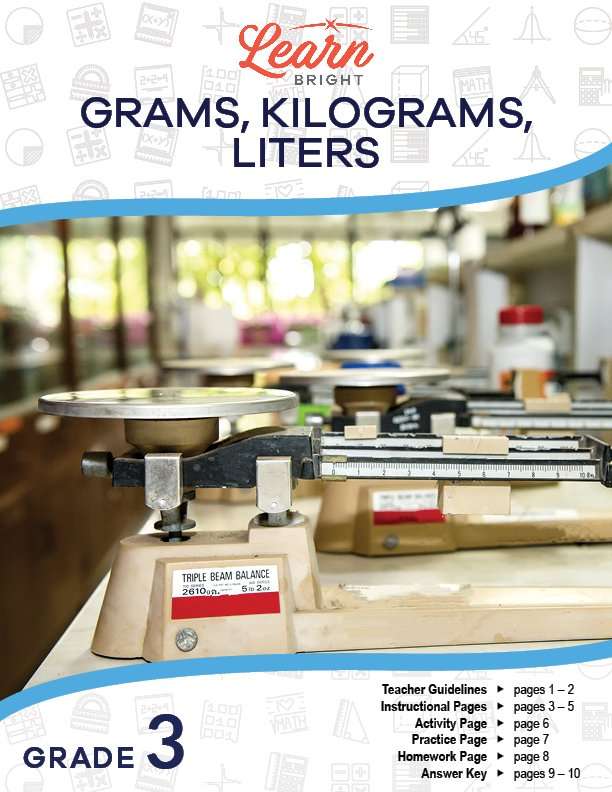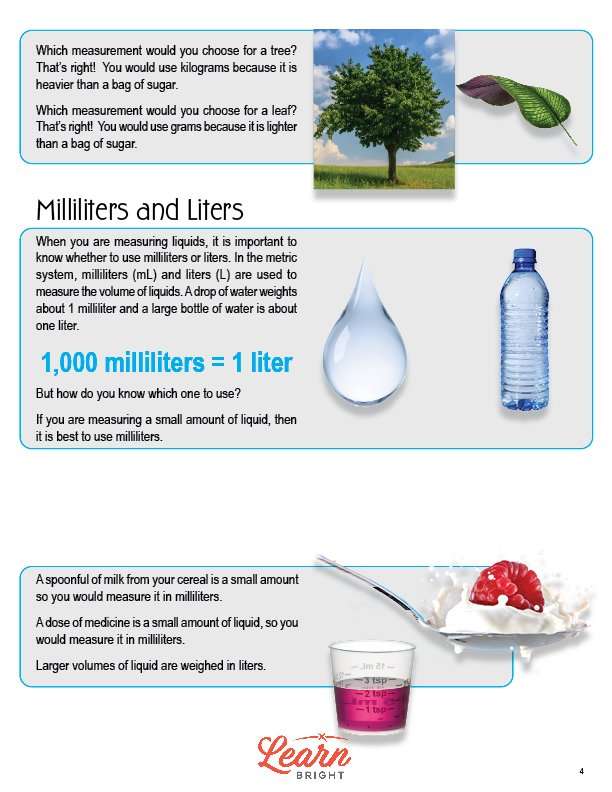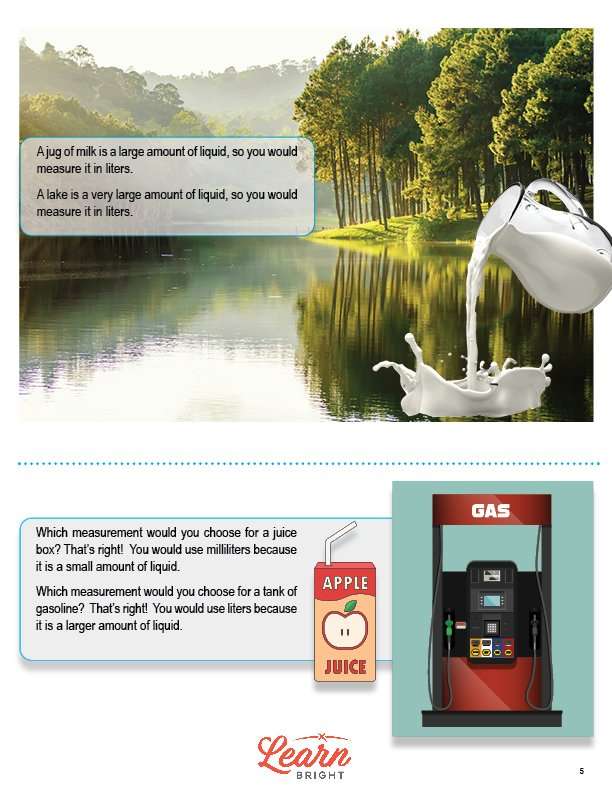Description
What our Grams, Kilograms, Liters lesson plan includes
Lesson Objectives and Overview: Grams, Kilograms, Liters teaches students about grams, kilograms, and liters, including what they are and when each should be used. At the end of the lesson, students will be able to measure and estimate liquid volumes and masses of objects using standard units of grams (g), kilograms (kg), milliliters (ml) and liters (l). This lesson is for students in 3rd grade.
Classroom Procedure
Every lesson plan provides you with a classroom procedure page that outlines a step-by-step guide to follow. You do not have to follow the guide exactly. The guide helps you organize the lesson and details when to hand out worksheets. It also lists information in the blue box that you might find useful. You will find the lesson objectives, state standards, and number of class sessions the lesson should take to complete in this area. In addition, it describes the supplies you will need as well as what and how you need to prepare beforehand. The supplies needed for this lesson include scissors, glue, and extra paper.
Options for Lesson
Included with this lesson is an “Options for Lesson” section that lists a number of suggestions for activities to add to the lesson or substitutions for the ones already in the lesson. One optional addition to this lesson is to give your students a variety of objects and have them weigh each object in grams or kilograms and record their answers. You could also have your students make a list of objects in their bedroom or outside that would be measured with grams, kilograms, milliliters, or liters.
Teacher Notes
The teacher notes page includes a paragraph with additional guidelines and things to think about as you begin to plan your lesson. This page also includes lines that you can use to add your own notes as you’re preparing for this lesson.
GRAMS, KILOGRAMS, LITERS LESSON PLAN CONTENT PAGES
Grams, Kilograms, Liters
The Grams, Kilograms, Liters lesson plan includes three pages of content. When weighing an object, you need to decide whether to use grams or kilograms. Grams (g) and kilograms (kg) are units used to weight objects in the metric system. For reference, a paperclip weighs about one gram while a bag of sugar weighs about one kilogram. 1,000 grams is equal to one kilogram.
But how do you decide which one to use? For objects that are lighter or that you have a small amount of, you should use grams. For example, a piece of paper is light, so you would measure it in grams. A handful of chocolate chips is a small amount, so you would measure them in grams.
For heavy objects, on the other hand, you should use kilograms. For example, a refrigerator is large and heavy, so you would measure it in kilograms. A cat is also relatively heavy, so you would measure it in kilograms as well.
Think about a tree. Should you use grams or kilograms to measure it? Definitely kilograms, because trees are very heavy! However, if you just wanted to weigh a single leaf from the tree, you would use grams because it’s small and light.
Milliliters and Liters
When measuring the volume of liquids, you have a similar decision to make between milliliters and liters. Milliliters (mL) and liters (L) are units used to measure liquid volume in the metric system. A drop of water is about one milliliter, while a large bottle of water is about one liter. Therefore, it you’re measuring a small amount of liquid, you should use milliliters. For large amounts of liquid, use liters.
If you wanted to measure a spoonful of the milk in your cereal, you would measure it in milliliters. A jug of milk, on the other hand, would be measured in liters since it’s a large amount of liquid.
Think about a juice box. Should you use milliliters or liters to measure it? Definitely milliliters, because juice boxes don’t contain a lot of liquid! However, if you wanted to measure the gas in a tank of gasoline, you would use liters since it’s a larger amount of liquid.
GRAMS, KILOGRAMS, LITERS LESSON PLAN WORKSHEETS
The Grams, Kilograms, Liters lesson plan includes three worksheets: an activity worksheet, a practice worksheet, and a homework assignment. You can refer to the guide on the classroom procedure page to determine when to hand out each worksheet.
CLASSROOM OBJECTS ACTIVITY WORKSHEET
The activity worksheet asks students to make a list of ten objects in the classroom and put a check in the box for the unit that would be best for measuring each item (grams, kilograms, or liters).
UNIT MATCHING PRACTICE WORKSHEET
For the practice worksheet, students will cut out the pictures on the worksheet and place it under the correct unit they would use to measure it (grams, kilograms, or liters).
GRAMS, KILOGRAMS, LITERS HOMEWORK ASSIGNMENT
The homework assignment asks students to look at the pictures on the worksheet, circling any that you could weigh in grams and drawing an X over any objects that you could weigh in kilograms. They will also circle the better unit to measure each object listed.
Worksheet Answer Keys
This lesson plan includes answer keys for the practice worksheet and the homework assignment. If you choose to administer the lesson pages to your students via PDF, you will need to save a new file that omits these pages. Otherwise, you can simply print out the applicable pages and keep these as reference for yourself when grading assignments.









